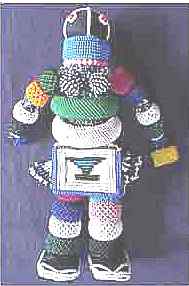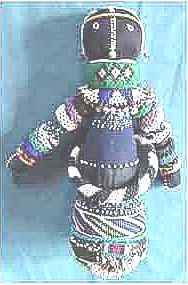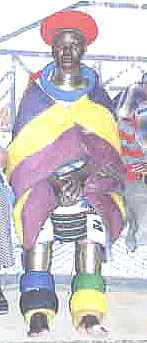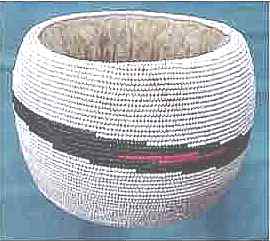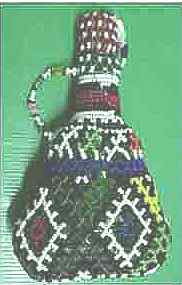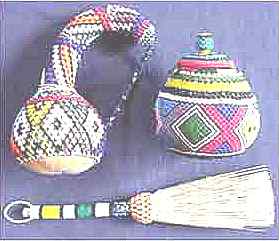 |
The Bead Site =Home>Uses of Beads>Cultural Decoration > Ndebele
~
|

|
Contemporary Beadwork of the Ndebele of South Africa
|

|
|
A beadworker at Esther's shop in KwaMhlanga district.
|
by Bucklee Bell
|
Botshabelo woman with beaded headpiece.
|
|
The Ndebele are a cultural group living in northeast South Africa in an area called the Transvaal or KwaNdebele, northeast of the capitol, Pretoria. They were originally part of the migration of Bantu cultural groups from Central and East Africa into southernmost Africa around 300-400 AD.
The Ndundza branch of the Ndebele (who primarily do the beadwork) were defeated by Boer (Dutch) settlers in 1885, and for five years were slaves on Boer farms. Freedom came in 1890, but to this day the Ndundza have been dependent on Boer farmers for work.
The Dutch took all the good farmland and the Ndebele were left landless. They suffered much during apartheid and this undoubtedly affected their beadwork.
Ivor Powell (1995:108) wrote, "As the Ndebele are concerned, the demonstrable history of beadworking goes back only as far as the second half of the nineteenth century, when Europeans bearing beads of Czechoslovokian origin penetrated the hinterland and came into contact with people living in present day Transvaal."
Because there are photographs and examples of sophisticated beadwork from this period. I think its safe to assume the Ndebele didn't just start doing intricate beadwork in the late 1800's, but must have had some beadworking tradition before this time.
|
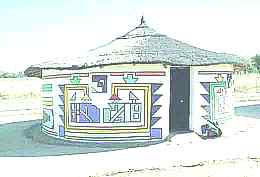
|
Up until World War Two, Ndebele beadwork was done in predominately white seed beads with a few simple designs, usually in black, blue or red. Grasses were used for thread.
After the war they started using more color in their striking designs. They matched the beadwork designs with those they painted on their houses, for which they are equally famous.
|
|
In the summer of 1999 I visited South Africa for the first time and was impressed by the volume and quality of the beadwork for sale. I believe that the Ndebele are one of the most prolific beadworkers on the planet. I visited several places they sell their beadwork, including:
|
The Saturday Flea market and Bruma Lake market in Johannesberg.
The market near the zoo entrance In Pretoria.
Botshabelo Village north of Middleburg.
Ndebele Traditional Village and Museum near Loopspruit Winery, north of Bronkhorstpruit.
KwaMhlanga village, especially the Esther Curio Shop (right). Esther is a famous Ndebele artist who has painted Ndebele designs on airplanes, Mercedes Benzes, etc. She was at an art exhibit in Europe, so I missed her.
|
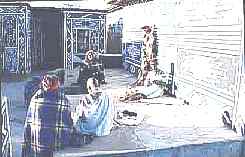
|
|
The Beadwork
|
The Ndebele produce beadwork for small trinkets and intricate beaded trains, capes and aprons.
One of the most commonly seen is the nyoga (right). They are approximately three to five inches (7.5 to 12.5 cm) wide by three to four feet (90 to 120 cm) long.
They are based on the bridal train worn by Ndebele women in the early twentieth century.
|
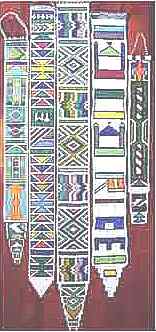
|
|
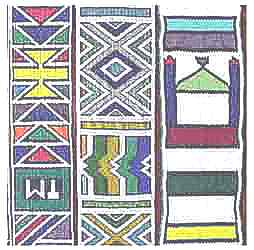
|
They are now made (left) using many colors and designs similar to their house paintings. These pieces are interesting in that the beadwork stands alone without backing sewn to it. The weaving process is done by hand and there is no loom. I think size 100 seed beads are used. Some beadworkers call it the " Ndebele Herringbone Weave." According to Blakelock (1990:70), "This is a simple off loom technique which produces a dense mat of beads in a pattern reminiscent of herringbone or knit. The beads incline towards one another in pairs, with only a tiny bit of thread showing." Nice strong pieces of beadwork.
|
|
The Ndebele make modern copies of their traditional aprons. There are several styles of apron according to the woman's age and marriage status. The isiphephetu or pepetu (Carey 1986:37) is a rectangular flat stiff apron (right). Mothers make them for unmarried daughters who have undergone female initiation rites. In recent times these are beaded on canvas instead of leather.
|
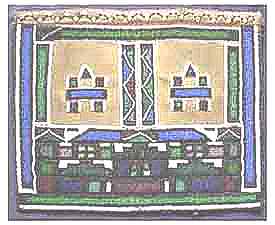
|
|
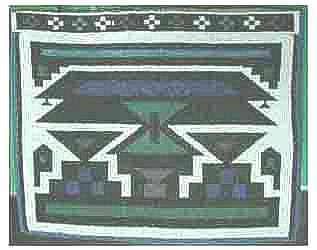
|
The work on this piece (left) appears to be a single herringbone weave attached to the stiff backing.
|
|
Another type of apron commonly seen and reproduced for the tourist trade is the jocolo (Carey 1986:33, 37) or amajogolo (Mountain 1995: 35). This is usually a fully beaded leather apron (right) with five fingers at the bottom and beadwork done in lazy stitch. These are married women's aprons.
|
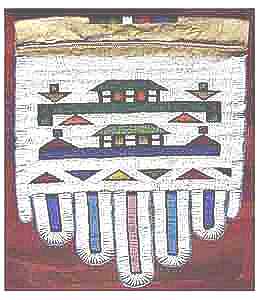
|
|
|
|
The Ndebele make some very fine beaded baby dolls that display miniature examples of the adult woman's beaded wardrobe.
|
|
|
In particular the dolls usually have beaded izigolwani (far right), large hoops worn around the neck, arms, waist and legs of properly attired Ndebele women (center).
|
|
|
|
|
Some items in a more commercial vein are gourds and bottles with a net weave over them.
On the right is also a small broom with a beaded handle.
|
|
|
|
Beaded animals such as this wooden crocodile are also sold as souvenirs. The seed beads on these objects are beaded with string and beaded around the object
|
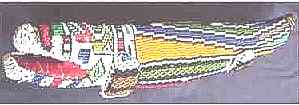
|
|
Many Ndebele products are available over the Internet. The buyer should be aware of quality and workmanship before buying anything.
REFERENCES CITED
Blakelock, Virginia (1990) Those Bad, Bad Beads. Privately published, Wilsonville OR (USA).
Carey, Margaret (1986) Beads and Beadwork of East and South Africa. Shire Publications, Aylesbury, UK.
Clarke, Duncan (1998) African Hats and Jewelry. Chartwell Books, London.
Durant, Judith and Jean Campbell (1998) The Beaders Companion. Interweave Press. Loveland, CO (USA).
Fisher, Angela (1984) Africa Adorned. Harry N. Abrams. New York.
Mountain, Alan (1995) Ndebele Artist Nation. Struik Publishers, Capetown.
Powell, Ivor (1995) Ndebele, A People and their Art. Cross River Press, New York.
© 2000 Bucklee Bell
______________________________________________________
Small Bead Businesses | Beading & Beadwork | Ancient Beads | Trade Beads
Beadmaking & Materials | Bead Uses | Researching Beads | Beads and People
Center for Bead Research | Book Store | Free Store | Bead Bazaar
Shopping Mall | The Bead Auction | Galleries | People | Events
The Bead Site Home | Chat Line | Contact Us | Site Search Engine | FAQ
|
 |









